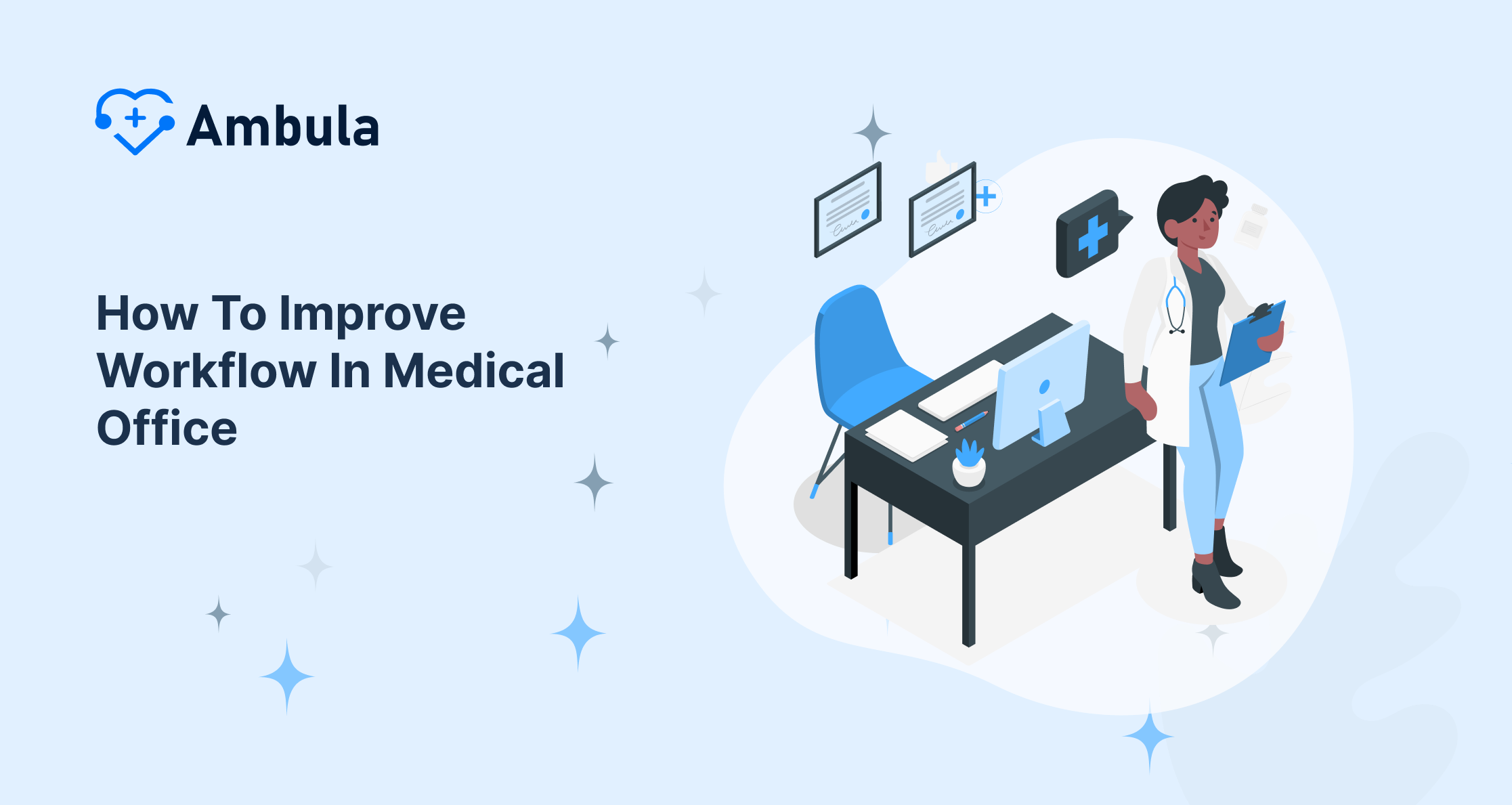
Delivery In today’s changing healthcare scene, making clinical workflows better has become a must for medical practices. As patients expect more and rules get stricter, providers need to balance giving good care and running things. This full guide digs into the complex world of medical office workflows, giving healthcare pros a plan to make big changes in how they do things at their clinics.
Embracing the Necessity of Streamlined Workflows
The relentless pace of medical practice often relegates long-term planning to the back burner, overshadowed by the urgency of immediate patient needs and administrative tasks. However, failing to prioritize workflow optimization can have far-reaching consequences, from diminished patient satisfaction to compromised clinical outcomes and financial strains.
Fortunately, the path to a more streamlined and efficient future state is within reach, albeit requiring an upfront investment of time and a willingness to modify entrenched practices. By adopting a proactive approach to workflow enhancement, medical practices can unlock a myriad of benefits, including:
Better Efficiency and Output
In today’s customer-focused health sector, patients want great medical results and a smooth easy experience. A good workflow cuts down on problems and holdups, helping patients have a good time from when they arrive to when they leave. Also, better processes mean you can predict how many patients you’ll see, less paperwork, and better use of what you have. This leads to more work getting done and more money coming in.
Less Mistakes and Lower Risks
Healthcare works on a thin line where even small slip-ups can cause big trouble. By putting in place systems that work on their own and using them in a good workflow, doctors’ offices can cut down on mistakes that come from missing or incomplete info. This keeps patients safe and helps the office keep its good name.
Better Patient Care and Results
Uniform central and well-controlled processes give doctors quick access to key patient info. This helps them make smart choices and give personal top-notch care. A smooth workflow makes patients happier and leads to better health results, which is what every doctor wants.
Happier Staff Who Stay Longer
A standard and smooth way of doing daily tasks saves time and cuts down stress for doctors and their helpers. When a medical office runs without many hiccups, it lowers the chance of staff burning out. This creates a team that’s more into their work, gets more done, and likes their job better. In the end, more people want to keep working there.
Mapping the Journey: Understanding Your Current Workflows
Before you start to optimize your workflows, you need to grasp your practice’s existing processes. Even though you might feel familiar with your daily routine, most healthcare professionals don’t see the big picture of how people, processes, and technology work together in their operations.
To begin this process, think about these steps:
- Build teams across departments: Get staff from different areas to work together on mapping out how things are done now. Let them talk and feel like they’re part of the process. Their knowledge will be the starting point for making things better.
- Pinpoint what’s not working: It’s easy to spot problems, but figuring out why they happen takes more digging. Push teams to ask tough questions, like:
- Where are processes dependent on each other in sequence?
- Which steps are done more than once without need?
- Where do tasks done by hand slow things down?
- At what points do multiple sign-offs hold up progress?
- What do patients say about their experience?
- Watch and write down: Add to team input by seeing daily work firsthand. Write down processes, spot waste, and catch small details that people doing the job every day might miss.
By doing this full review, medical offices can get a complete picture of how things work now. This sets the stage to make specific improvements and build a workplace that’s open to change.
Building a Culture Ready for Change
Changing clinical workflows causes disruption even when the goal is to boost productivity and improve patient care. Doctors and staff might worry or push back if they don’t get why changes are happening or feel left out of decisions.
To build a workplace that welcomes change, you need to find and involve key people from the start. Who will the new processes affect? Make sure these folks do not understand the reasons for change (like better patient experiences, higher quality care, or more money coming in) but also have a say in shaping what’s to come.
What’s more, getting providers involved in the process has a big impact, even if they don’t seem to do much. To create a culture that’s ready to take on the journey to the best possible state, providers need to understand the reasons behind changes, have input in designing new processes, and feel like they own the outcome.
When medical practices encourage open talks clear information sharing, and team decision-making, they create an environment that welcomes change. This sets the stage for successful changes in how work gets done.
Envisioning the Optimal Future State
With a comprehensive understanding of the current state and a culture primed for change, medical practices can turn their attention to defining their optimal future state. By identifying and addressing pain points, redundancies, and manual processes, a new, streamlined workflow can emerge, one that maximizes efficiency and patient satisfaction.
To chart this course, consider the following steps:
- Prioritize high-impact areas: Identify the inefficiencies or bottlenecks that, if eliminated, would yield the most significant improvements. Experience has shown that tackling too many initiatives simultaneously often leads to failure. Instead, focus on one or two high-priority areas at a time.
- Conduct root cause analysis: Utilize tools such as root cause analysis to uncover the underlying “how” and “why” behind these sources of frustration. Resist the temptation to assign blame; instead, seek to understand the process-related causes and effects, and develop corrective actions.
- Leverage technology: Medical practices have invested heavily in technology to support every aspect of operations, from electronic health records (EHRs) to telemedicine platforms and patient portals. However, many fail to fully leverage the functionality of these systems, resulting in underutilized capabilities and suboptimal return on investment. Identify opportunities to close this gap and maximize the potential of existing technologies.
- Gather feedback and monitor performance: Once the new process is implemented, establish mechanisms to gather feedback from providers, staff, and patients. Monitor key performance indicators (KPIs) associated with the process, particularly those related to revenue, access, and patient satisfaction, to ensure that outcomes are trending in the desired direction.
- Invest in continuous training: Staff training and development are critical to sustaining the new workflows. Implement routine training programs and competency assessments, and include workflow education in new employee onboarding to ensure subject matter expertise is maintained despite staff turnover.
- Document and update processes: Capture the new workflows in comprehensive documentation, such as standard operating procedures (SOPs), training manuals, or tip sheets. Regularly review and update these materials to ensure they remain current and reflective of best practices.
By following this roadmap, medical practices can transition from their current state to an optimized future, one that prioritizes efficiency, accuracy, and patient-centered care, while fostering a culture of continuous improvement.
Harnessing the Power of Automation
Automation emerges as a powerful ally in the quest for streamlined clinical workflows, offering solutions that can transform manual, time-consuming tasks into seamless, efficient processes. By leveraging the right technologies, medical practices can unlock a wealth of benefits, including:
Streamlined Administrative Tasks
Administrative tasks, such as appointment scheduling, patient reminders, and billing, can be significant time sinks for staff, diverting valuable resources away from direct patient care. Automation solutions can alleviate these burdens, enabling practices to:
- Implement automated appointment reminders via secure text, email, or pre-recorded phone calls, reducing no-shows and improving patient engagement.
- Transition to paperless check-in and check-out processes, minimizing bottlenecks and enhancing patient flow.
- Integrate digital alternatives for outdated technologies like fax machines and paper records, fostering a more seamless exchange of medical documentation.
Enhanced Clinical Decision Support
Automation can also play a pivotal role in supporting clinical decision-making, empowering providers with real-time, relevant data and reducing the risk of diagnostic errors. Examples include:
- Clinical decision support systems (CDSS) that provide actionable recommendations automatically, integrated into the clinician’s workflow.
- Artificial intelligence (AI) solutions that deliver personalized, point-of-care learning by analyzing practice data, online search queries, and assessments.
- Natural language processing (NLP) applications that extract structured data from physician notes, reducing documentation burdens and improving data accuracy.
Optimized Revenue Cycle Management
Digital solutions to manage revenue cycles can make patient communication, billing, and payment processes smoother putting all data in one place. Cloud-based RCM software gives medical providers a way to bring together claims filing, invoicing, payment transactions, appointment scheduling, and patient data. This allows them to make decisions based on data and boost their financial results.
Virtualization and IT Consolidation
Virtualization tech has a big impact on bringing together and improving IT systems. It helps deliver key services and while cutting down on overlap and waste. As healthcare groups start to go digital, virtualizing apps and desktops becomes key to supporting clinical workflows. This is true for electronic health records (EHRs) and remote work projects.
Automation can help, but you’ve got to pick the right tools for your medical practice. Look for vendors who know healthcare inside and out. Take a close look at how your clinic runs day-to-day, and go for solutions that are easy to use, keep data safe, and follow all the rules.
Making Clinical Processes the Same for Everyone
When clinical processes aren’t consistent, it can mess up even the best plans to improve how things work. Making things standard is key to boosting quality, so start doing this when you’re putting in any new system or process.
Medical practices can create smooth, efficient ways of working that cut out repetition and focus on what matters. They can do this by setting best practices for everyone and getting rid of individual ways of doing things. Here are some ideas to think about:
- Value-stream mapping: Utilize value-stream maps to visualize the flow of work for various clinical conditions or processes. Identify steps that directly add value to the patient experience (e.g., receiving treatment) and those that do not (e.g., waiting times, unnecessary motion, or duplication of efforts). Eliminate or redesign non-value-added steps to streamline workflows.
- Process standardization: Once best practices have been identified, standardize them across the organization. This may involve developing standard operating procedures (SOPs), training manuals, or tip sheets that clearly outline the optimal process for each clinical scenario.
- Practice and reinforce: Treat your staff like a professional sports team, walking them through the new processes until they become second nature. Conduct regular training sessions, simulations, and competency assessments to reinforce the standardized workflows and address any deviations or knowledge gaps.
- Continuous improvement: Standardization is not a one-time event but an ongoing process. Regularly review and update your standardized processes to reflect changes in best practices, regulatory requirements, or technological advancements.
By embracing standardization, medical practices can foster consistency, reduce variability, and create a foundation for continuous improvement, ultimately enhancing patient care and operational efficiency.
Optimizing Electronic Health Record (EHR) Systems
Electronic health records (EHRs) have caused a revolution in the healthcare industry. They help providers manage patient data, streamline clinical documentation, and improve care coordination. However, their effect on workflow efficiency and usability remains a topic of ongoing debate.
To optimize EHR systems and make them fit clinical workflows better, think about these strategies:
- Clinician-centered design: Work with EHR vendors to customize clinical workflows and user interfaces for your practice, specialty, or care setting. Show the most-used information and features front and center, so providers can use the system more cutting down on frustration and boosting productivity.
- Workflow integration: Look for EHR solutions that work with other clinical apps and systems allowing two-way data sharing and getting rid of the need to enter data twice or by hand. This integration should go beyond just clinical systems to include things like patient portals, telemedicine platforms, and tools to manage the money side of healthcare.
- Usability assessments: Perform usability checks to spot areas where the EHR system might slow down clinical work or create potential risks to patient safety. Get end-users involved, watch how they use the system, and collect their thoughts on problems and ways to make things better.
- Continuous optimization: Making EHR better is an ongoing job, not a one-off task. Set up a specific team or group to keep an eye on how the system is doing, find ways to improve it, and put in place targeted upgrades or customizations to keep up with changing clinical needs and best practices.
By focusing on designs that put clinicians first smooth integration, and ongoing improvements medical offices can change their EHR systems. These systems can become more than just tools to record information. They can turn into powerful aids that boost efficiency and improve patient care quality.
Using Lean Methods
Toyota first developed lean methods, which have become popular in healthcare. These methods help to cut waste, boost efficiency, and make patient care better. When medical offices understand and improve each step in a process, they can spot and remove tasks that don’t add value. This streamlines work and makes the best use of resources.
To use lean ideas in your medical office, think about these strategies:
- Value-stream mapping: As we talked about before, value-stream mapping helps you see and study clinical processes . It lets you spot steps that add value and those that don’t showing you where to make things better and how to redesign workflows.
- Root cause analysis: Lean methods focus on finding and fixing the real reasons for inefficiencies or mistakes, not just dealing with the surface problems. Use tools like root cause analysis, fishbone diagrams, or the “5 Whys” technique to uncover what’s causing workflow bottlenecks or quality issues.
- Continuous improvement: Lean thinking puts an emphasis on ongoing enhancements. Small, step-by-step changes can lead to big long-term gains. Create an atmosphere where staff feel empowered to spot and propose ways to improve processes. Put in place a clear system to evaluate and implement these ideas.
- Visual management: Tools that help you see things , like kanban boards, performance dashboards, or process flow diagrams, can make a big difference. They show where work gets stuck and where things could get better. This helps keep staff involved and responsible for their work.
- Kaizen events: Kaizen events also known as rapid improvement events, bring together teams from different departments to analyze and enhance a specific process or workflow in a short time. These events can spark change creating momentum and support for lean projects.
By using lean methods medical practices can build a culture that always tries to get better, cut out waste, and make clinical processes work better. This leads to improved patient care happier staff, and better overall performance.
Teamwork Across Different Medical Fields and Working Together in Care
In today’s tricky healthcare world, one doctor or field alone can’t meet patients’ many needs. Models that focus on teamwork across fields and coordinating care have become a strong way to make clinical processes better and help patients more.
When doctors, nurses, pharmacists social workers, and other health experts work together medical practices can:
- Make care transitions smoother: Make sure care transitions between different settings or providers go cutting down on gaps in communication repeated efforts, or treatment delays.
- Boost care coordination: Help care team members share patient information, treatment plans, and progress updates leading to better-informed decisions and lowering the risk of mistakes or clashing treatments.
- Use a range of expert skills: Draw on the special knowledge and abilities of different healthcare pros giving patients well-rounded care that looks after their physical, mental, and social needs.
- Get patients more involved: Working together in care teams helps patients take part in their own care. This leads to better understanding and following of treatment plans.
- Make work flow smoother: Care teams with clear roles and duties can cut down on duplicate work. They also help team members talk better and use resources in the best way.
To put collaborative care models into action medical practices should:
- Set up clear protocols and communication channels to coordinate care and share information.
- Put money into team-based training and education across professions to build a shared grasp of roles, duties, and best ways of doing things.
- Use tech solutions, like secure messaging platforms or shared electronic health records, to make working together and exchanging data easy.
- Often check and improve workflows to make sure they match the changing needs of the care team and patients.
By adopting collaborative care models and encouraging teamwork across disciplines medical practices can make clinical workflows better, improve patient results, and set themselves up as leaders in providing high-quality coordinated care.
Integrating Patient-Centered Design
When we aim to make clinical workflows better, we need to think about what patients want and how they feel. Getting patients and their families involved in creating and improving healthcare processes is key to patient-centered design. This approach makes sure workflows match what patients need, like, and care about.
By bringing patient-centered design into efforts to improve workflows medical practices can:
- Boost patient satisfaction: By grasping and bettering patient involvement and treatment plan follow-through, as workflows are created to meet their specific needs and likes.
- Better communication: Spot ways to enhance patient-provider talks making sure info is shared and patients feel they can ask questions and speak up about worries.
- Cut down on paperwork: Make tasks like booking appointments signing up, and paying bills easier, cutting down on headaches and making patients’ overall experience better.
- Build trust and openness: By getting patients involved in the design process medical offices can show they’re committed to being open creating stronger bonds between patients and providers.
To bring in patient-focused design, think about these approaches:
- Set up patient advisory councils or focus groups to get feedback and insights on current processes and suggested changes.
- Do ethnographic research by watching patients as they move through different touchpoints in the practice, to spot problems and areas to make better.
- Use patient portals, surveys, and social media to collect feedback and understand what patients prefer and expect.
- Include patients and their families when designing and testing new workflows making sure their views are part of the whole development process.
- Often check and improve workflows based on ongoing patient feedback creating a culture that always aims to get better and puts patients first.
When medical practices use patient-focused design ideas, they can make their clinical work better. This has an impact on how well they run things and gives patients a good experience that makes them feel in control. In the end, this helps improve health results and builds stronger connections between patients and their healthcare providers.
Leveraging Data-Driven Insights
In the era of big data and advanced analytics, medical practices have access to a wealth of information that can inform and guide workflow optimization efforts. By leveraging data-driven insights, practices can identify bottlenecks, uncover hidden inefficiencies, and make informed decisions about process improvements.
To harness the power of data in workflow optimization, consider the following strategies:
- Establish a robust data infrastructure: Invest in robust data collection, storage, and analysis systems that can capture and integrate data from various sources, including electronic health records (EHRs), practice management systems, patient portals, and wearable devices.
- Identify key performance indicators (KPIs): Define and track relevant KPIs that align with your practice’s strategic goals and workflow optimization objectives. These may include metrics related to patient throughput, wait times, staff productivity, revenue cycle performance, and patient satisfaction.
- Conduct process mining: Process mining techniques leverage event log data from information systems to visualize and analyze end-to-end processes, identifying bottlenecks, deviations from standard workflows, and opportunities for improvement.
- Implement predictive analytics: Leverage advanced analytics techniques, such as machine learning and artificial intelligence, to develop predictive models that can anticipate patient volumes, resource requirements, and potential workflow disruptions, enabling proactive planning and optimization.
- Dashboards and data visualization: Develop interactive dashboards and data visualization tools that present key performance indicators and workflow metrics in a clear, intuitive manner, enabling stakeholders to quickly identify areas of concern and monitor the impact of process improvements.
- Continuous monitoring and refinement: Treat workflow optimization as an iterative process, continuously monitoring performance data and refining processes based on emerging insights and changing operational requirements.
By embracing data-driven decision-making, medical practices can move beyond anecdotal evidence and gut instincts, instead relying on objective, quantifiable data to drive workflow improvements and ensure that resources are allocated effectively to areas with the greatest potential for impact.
Fostering a Culture of Continuous Improvement
Optimizing clinical workflows is not a one-time event but rather an ongoing journey of continuous improvement. As healthcare practices evolve, new technologies emerge, and patient expectations shift, medical practices must remain agile and adaptable, continuously refining their processes to align with best practices and industry standards.
To foster a culture of continuous improvement within your medical practice, consider the following strategies:
- Leadership commitment: Ensure that practice leaders, including physicians, administrators, and department heads, are fully committed to the principles of continuous improvement and actively participate in workflow optimization initiatives.
- Establish a dedicated team or committee: Assemble a cross-functional team or committee responsible for identifying opportunities for improvement, evaluating proposed changes, and overseeing the implementation and monitoring of new workflows.
- Empower staff and encourage feedback: Encourage staff at all levels to identify potential areas for improvement and provide feedback on existing processes. Establish formal mechanisms to capture and evaluate staff input, such as suggestion boxes, town hall meetings, or online forums.
- Celebrate successes and learn from failures: Recognize and celebrate achievements in workflow optimization, fostering a sense of pride and motivation among staff. Conversely, failures or setbacks should be treated as learning opportunities, encouraging open discussion and analysis to identify root causes and prevent future occurrences.
- Invest in training and development: Provide ongoing training and professional development opportunities for staff, ensuring that they remain up-to-date with the latest best practices, technologies, and industry standards related to workflow optimization.
- Leverage external expertise: Collaborate with industry experts, consultants, or academic institutions to gain fresh perspectives, access cutting-edge research, and learn from best practices implemented in other healthcare settings.
- Benchmark and share best practices: Participate in industry benchmarking initiatives and professional networks to share best practices, learn from the experiences of other medical practices, and stay informed about emerging trends and innovations in workflow optimization.
By cultivating a culture of continuous improvement, medical practices can remain at the forefront of clinical excellence, consistently delivering high-quality, efficient care that meets the evolving needs of patients and stakeholders.
Conclusion: Embracing the Future of Healthcare Delivery
As healthcare changes making clinical workflows better has become crucial for medical practices that want to succeed in this changing scene. By using the plans in this guide—from automation and lean methods to team-based care models—healthcare pros can cause a revolution in their work, boosting both productivity and patient happiness. Always trying to get better not only leads to long-term success but also puts practices at the top of healthcare breakthroughs. Looking ahead, those who focus on making workflows better will be ready to handle challenges and grab chances, in the end, changing how healthcare is given. Want to change your practice’s workflow? Ambula offers new solutions to help doctors manage their patients in the best way. Fill out our form today, and let us help you make your clinic’s workflow better for amazing success.






